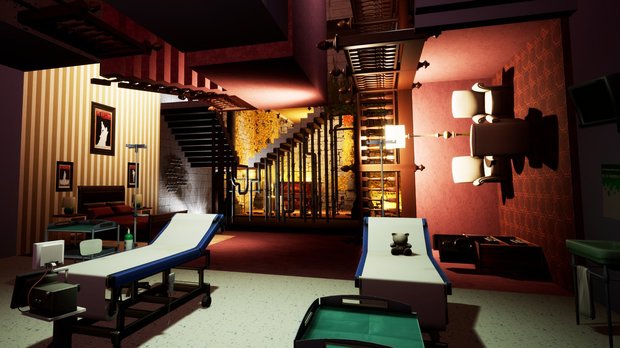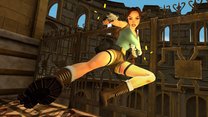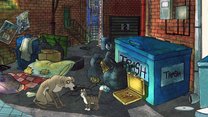Tape: Unveil the Memories review

- 0 Comments
Time manipulation thriller can’t quite stick the landing
Tape: Unveil the Memories, the first release by indie developer BlackChiliGoat Studio, bills itself a narrative mystery adventure where you can rewind time, which gave me the impression I would be playing a clever time travel game. So when that didn’t happen, I was initially disappointed. However, once I framed it as a Portal-type stealth mission, I began to enjoy myself. Unfortunately, the enjoyment didn’t last either, as this disjointed narrative and not so user-friendly interface make the game difficult to recommend after all.
Iria, a girl being raised by a single mom in northern Spain in the late 90s, finds a VHS tape her father (an acclaimed director of horror films) sent her in the mail. Playing the tape triggers Iria to dissociate, and you’ll spend the rest of game inside her mind exploring her family’s dark secrets, which she has presumably repressed. To access them, you must use a video camera to manipulate objects that prevent your progress and also to ward off Iria’s own demon, which skulks around many areas of her subconscious, ready to put her into a coma to prevent her from realizing the truth. I wish I could make that sound less convoluted, but the conceit is never explained more thoroughly.
The two main areas you’ll visit are Iria’s childhood home and an asylum where her father worked. Gameplay is presented in the first person, using the mouse and keyboard to freely move around and interact with the 3D environment. Navigation is simple, with the only thing to do besides walking and running being the occasional crouch to get through some tight spots. Why Iria’s mind allows her to crouch but not jump or climb is never explained, other than many of the game’s puzzles would be solved rather quickly otherwise. Picking up objects and opening doors is done with a keystroke after using the mouse to highlight them, when left-clicking would have been much more fluid for any player on PC. Not only that, Iria snatches everything up as if she’s stealing it away from someone else, and the animation becomes obnoxious after a while. There is an option to play with a gamepad, though I found the presets unintuitive and there’s no way to remap the buttons.

Soon you’re introduced to the video camera that can rewind or fast-forward time a very short way. The mechanic is quite similar to that in Braid, though it’s not nearly as seamless. For example, in one room the solution to advancing may be focusing on a shelf that’s tipped over, rewinding it back in time seven seconds until it’s standing upright, and then moving past it. However, in the next room a similar shelf may be blocking your path, but the camera doesn’t work on it at all. This inconsistency remains consistent throughout, with seemingly obvious solutions to puzzles simply not available. The camera will highlight specific items that can be manipulated, but only those objects can be moved at that time, with no explanation given.
A major misstep is the need to “charge” your camera. Iria can only rewind or fast-forward the tape over a 15-second time span. If she’s reached the beginning of the tape, she can no longer rewind, and if she’s reached the end of the tape, she can no longer fast-forward. This becomes a problem as most rooms only have items that need to be moved in one direction. The solution? Find a random object (usually a rocking horse) and move it backwards or forwards in time to give you space on the tape. Sometimes the horse is rooms away, arbitrarily lengthening puzzles and forcing you to run past her demon more often.
In addition to moving objects, Iria can also pause time. Puzzle-wise, this is used primarily to freeze secure hospital doors that can only be opened remotely from a faraway desk. However, it can also be used to fend off the rather large demon wandering about many rooms in Iria’s mind. If you’re overcome by it, your mind slips away and you are sent back to the previous room to try again. While it’s relatively slow and somewhat simple to duck around, you can also “pause” it with the camera, which causes it (and Iria) to scream, giving you a couple of seconds to escape. I am sure there is some symbolic meaning here (especially since a large symbol appears on the screen afterwards), but it also has no explanation. (For those inclined, there is an option to play a “narrative” version of the game which eliminates the worry about being caught by the demon.)

A lot of this could be forgiven if the story was compelling, but it struggles to move beyond well-explored horror tropes. You’ll learn Iria’s dark family secret when she does, mostly through reading damning letters that people just left lying around. Not only is the delivery of important information repetitive (seriously, no faxes or computer files to explore?), the reveals are consistently vague enough that we have a tough time tracking who’s involved in the mystery or why we should care about them. In fact, the only character we discover anything of substance about is Iria’s father, who speaks to her a few times throughout the game via additional VHS tapes. But even then, the script and acting are so poor (in addition to having some localization mistakes) that I couldn’t empathize with Iria’s own feelings about her dad.
While many of the puzzles are as simple as reconstructing broken doors or moving objects around a room in order to pass, a few are entertaining and all occur in the back half of the game. One creepy and effective puzzle involves a creative use of a mirror. Another entails rotating parts of a house 360 degrees multiple times in order to connect various stairways you need to climb. The strongest puzzle, and the highlight of the game, involves Iria entering her childhood bedroom as it was (and as she was, a couple feet tall) as a toddler, navigating toys and books and shelves to find the exit, all while avoiding a toddler-size demon. If only more of the game had been this charming.
Tape’s graphics are a mixed bag. The asylum, which takes up the first half of the game, is woefully drab, even for a hospital. Background objects are repeated ad nauseam, and it becomes difficult telling some hallways and doorways apart. And the few things that are visually interesting (e.g. a bright floppy disk next to a computer) cannot be used in any meaningful way. Thankfully, the second half contains many visual delights as you explore Iria’s childhood home while her mind warps rooms into what actually feel like creations of her imagination. Another nice trick employed frequently is that rooms suddenly change or even disappear behind you. Entering through a door, then looking back to find it gone, fabulously adds to the claustrophobia.
The use of sound is minimalist and effective. Mostly you can just hear your footsteps echo among the ambient noise, with occasional doses of eerie music. There are a couple of jump scares that would be obnoxious if done frequently but are rare enough to effectively tighten the nerves instead.
I encountered one significant graphical bug. At one point the demon just disappeared, with the only cues being the occasional colored pixel appearing and the sound of its footsteps. It took me a while to realize this wasn’t intentional, and while resetting the game fixed the problem, I had to wait until I reached a checkpoint to ensure I didn’t lose my progress. For a game that relies heavily on stealth, I don’t mind checkpoints, but the on-screen notification is fairly inconspicuous and there were times I wasn’t sure where my game would restart from if I exited.
There are four endings, entirely based off of two choices you make in the last chapter that allow Iria to decide who in her family she will forgive or not forgive. The denouements are quite varied, though it is tough to care about any of them as I felt nothing about Iria or anyone else in her family. One nice feature is a “Director’s Cut” that allows you to jump directly to both crucial decisions, allowing you to see each ending in a matter of minutes. While I did enjoy many of the puzzles in the final chapter, it would not have been worth it to start over and play through the game four different times. The game does have a warning for adult content, which is optional to display, but suffice it to say the themes are incredibly dark and disturbing, definitely not appropriate for children or those looking for a light story.
Final Verdict
It is difficult to think of an audience that I would recommend Tape: Unveil the Memories to. The story treads no new ground and never quite materializes into a coherent narrative. The stealth action is not difficult enough for those looking for action, and the narrative-only option doesn’t provide enough suspense without it to overcome the mediocre story. And while there are several good puzzles, they are late in arriving and scattered among many repetitive ones. Add that to the occasional bug and poor localization, and there’s no real reason to play this when there are more polished games on the market.
Hot take
Tape: Unveil the Memories is a creative indie adventure that does its best to appeal to suspense lovers whether they prefer stealth or story, but a middling narrative and inconsistent puzzles make it feel like more of a chore than a thrill.
Pros
- Particular sections of the game are visually arresting
- A few puzzles are creative and satisfying to solve
- Narrative option available for those who only want the story and puzzles
Cons
- Game mechanics are generally clunky
- Story is uninspired and incohesive
- Most puzzles and stealth action are overly simple
- Occasional graphical bugs and poor localization
Beau played Tape: Unveil the Memories on PC using a review code provided by the game's publisher.










0 Comments
Want to join the discussion? Leave a comment as guest, sign in or register.
Leave a comment